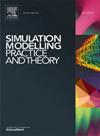Numerical study on the reinforcement mechanism of prestressed bolts based on the reconstruction of coal fracture structures
IF 3.5
2区 计算机科学
Q2 COMPUTER SCIENCE, INTERDISCIPLINARY APPLICATIONS
引用次数: 0
Abstract
The presence of structural weak planes severely affects the stability of the surrounding rocks in underground engineering and the safety of deep resource extraction. This study utilized the discrete element method to simulate and reconstruct the fracture network in the surrounding rocks. A model of the anchored solid containing a fracture network was established using a synthetic rock mass approach. Confined compression tests were conducted on anchored models with different support densities and pretension forces. The results indicate that both high support density and high pretension force can enhance the mechanical properties of fractured anchored solids to varying degrees, significantly improving the bearing capacity during the plastic phase. Additionally, high support density and pretension force can notably alter the failure mode of the anchored solid under load, reducing lateral displacement, delaying the initiation of primary fractures, and decreasing the number of newly formed fractures. From the perspective of prestressed load bearing, increasing anchor density or applying a high pretension force facilitates the formation of a wide and high-strength effective compressive stress zone. This in turn reduces the opening and sliding of primary fracture fields, the generation and propagation of secondary fractures, improves the stress state of the anchored solid, and enhances the overall strength of the surrounding rocks within the anchoring range. From the viewpoint of energy absorption and dissipation, increasing anchor support density and pretension force can significantly improve the ability of surrounding rocks to absorb external input energy, enhance the disturbance resistance of the anchored solid, and slow down the release of strain energy. The modeling process and research findings of this study offer valuable insights for analyzing structural failure and stability control in fractured rock masses.
基于裂隙结构重构的预应力锚杆加固机理数值研究
结构薄弱面的存在严重影响地下工程围岩的稳定性和深部资源开采的安全。本研究利用离散元法对围岩中的裂隙网络进行模拟和重建。采用合成岩体方法建立了含裂隙网络的锚固体模型。对不同支护密度和预紧力的锚固模型进行了侧限压缩试验。结果表明:高支护密度和高预紧力均能不同程度地提高断裂锚固体的力学性能,显著提高塑性阶段的承载能力;此外,较高的支护密度和预紧力可以显著改变锚固体在载荷作用下的破坏模式,减少侧向位移,延迟初始裂缝的形成,减少新形成裂缝的数量。从预应力承载的角度来看,增加锚杆密度或施加较高的预紧力有利于形成宽而高强度的有效压应力区。这反过来又减少了主裂缝场的张开和滑动,减少了次生裂缝的产生和扩展,改善了锚固固体的应力状态,提高了锚固范围内围岩的整体强度。从能量吸收和耗散的角度来看,增加锚杆支护密度和预张力可以显著提高围岩吸收外部输入能量的能力,增强锚固固体的抗扰能力,减缓应变能的释放。本研究的建模过程和研究成果为分析裂隙岩体的结构破坏和稳定性控制提供了有价值的见解。
本文章由计算机程序翻译,如有差异,请以英文原文为准。
求助全文
约1分钟内获得全文
求助全文
来源期刊

Simulation Modelling Practice and Theory
工程技术-计算机:跨学科应用
CiteScore
9.80
自引率
4.80%
发文量
142
审稿时长
21 days
期刊介绍:
The journal Simulation Modelling Practice and Theory provides a forum for original, high-quality papers dealing with any aspect of systems simulation and modelling.
The journal aims at being a reference and a powerful tool to all those professionally active and/or interested in the methods and applications of simulation. Submitted papers will be peer reviewed and must significantly contribute to modelling and simulation in general or use modelling and simulation in application areas.
Paper submission is solicited on:
• theoretical aspects of modelling and simulation including formal modelling, model-checking, random number generators, sensitivity analysis, variance reduction techniques, experimental design, meta-modelling, methods and algorithms for validation and verification, selection and comparison procedures etc.;
• methodology and application of modelling and simulation in any area, including computer systems, networks, real-time and embedded systems, mobile and intelligent agents, manufacturing and transportation systems, management, engineering, biomedical engineering, economics, ecology and environment, education, transaction handling, etc.;
• simulation languages and environments including those, specific to distributed computing, grid computing, high performance computers or computer networks, etc.;
• distributed and real-time simulation, simulation interoperability;
• tools for high performance computing simulation, including dedicated architectures and parallel computing.
 求助内容:
求助内容: 应助结果提醒方式:
应助结果提醒方式:


